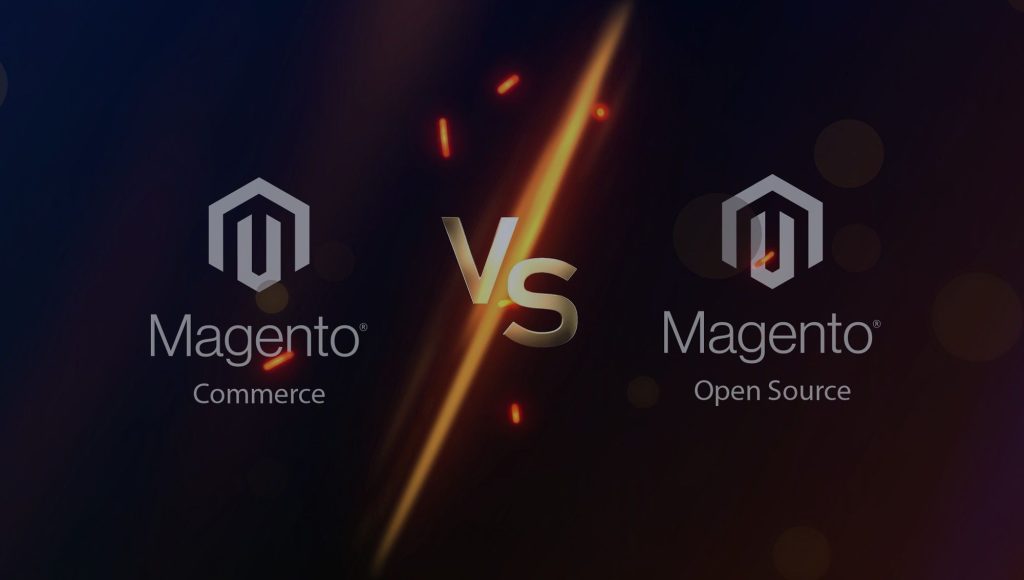Magento Commerce vs Magento Open Source: Difference and Prices
If you are just starting to get acquainted with Magento and have not yet had time to familiarize yourself with its versions, the success of your future online store depends on the decisions you make at this very moment. For this reason, in this article, we will answer the most common questions: what is the difference between paid and free Magento Commerce versions, what will suit you better, and how much will it cost. Let’s get started!
What is Magento Open Source?

Magento Open Source is a popular e-commerce platform that provides businesses with a flexible and customizable solution for building and managing online stores. It is a free, open-source software that allows businesses to modify and adapt the platform to fit their unique needs. Magento Open Source is built on PHP and uses a MySQL database to store data.
One of the most significant advantages of Magento Open Source is its extensive range of features. Magento 2 Open Source features include a user-friendly interface, customizable themes, search engine optimization tools, and a range of payment and shipping options. It also offers a variety of marketing tools, including customer segmentation and targeted promotions.
One of the most significant differences between Magento Open Source and Magento Commerce is the level of support and functionality. Magento Commerce is a paid version of the platform that offers more advanced features and support. It includes advanced marketing tools, support for B2B e-commerce, and a range of performance and scalability options. Magento Commerce also offers dedicated account management and technical support.
While Magento Commerce may be a better fit for larger businesses with more complex needs, Magento Open Source remains a popular choice for small to medium-sized businesses. It provides businesses with a scalable and customizable platform that can adapt to changing needs and support growth.
In conclusion, Magento Open Source is a powerful e-commerce platform that offers businesses a range of features and customization options. It is a free and open-source solution that can be modified to fit unique needs and preferences. While there are differences between Magento Open Source and Magento Commerce, both platforms offer businesses a range of tools and capabilities to succeed in the competitive world of e-commerce.
What is Adobe Commerce?

Adobe Commerce is an enterprise-level e-commerce platform that offers a range of features and capabilities to businesses of all sizes. It is built on the Magento platform, which is known for its flexibility and scalability. Adobe Commerce provides businesses with an out-of-the-box solution that can be customized to fit their unique needs and preferences.
One of the most significant advantages of Adobe Commerce is its comprehensive set of features. It includes advanced marketing tools, customer segmentation, and personalization capabilities, as well as support for B2B e-commerce. Adobe Commerce also offers a range of performance and scalability options, including cloud hosting and a dedicated infrastructure for high-volume stores.
Adobe Commerce is a paid platform, which means businesses have access to dedicated support and technical assistance. This is a significant difference between Magento Open Source and Adobe Commerce. While Magento Open Source is a free, open-source platform, Adobe Commerce provides businesses with a higher level of support and functionality.
Another difference between Magento Open Source and Adobe Commerce is the level of customization. While Magento Open Source is a flexible and customizable platform, Adobe Commerce offers businesses more advanced customization options. This includes support for custom extensions and integrations, as well as a range of pre-built modules that can be easily integrated into the platform.
In conclusion, Adobe Commerce is a powerful e-commerce platform that offers businesses a range of features and customization options. It is built on the Magento platform, which is known for its flexibility and scalability. While there are differences between Magento Open Source and Adobe Commerce, both platforms provide businesses with the tools and capabilities they need to succeed in the competitive world of e-commerce.
Adobe Commerce vs. Magento Open Source: How are they different?
Today we will look at two versions of Magento: Magento Open Source and Adobe Commerce (formerly Magento Enterprise Edition). Adobe Commerce is a paid version for large-scale e-commerce projects that need a large set of online store features for high-quality customer service. Adobe Commerce also offers its customers the options of a cloud solution or local project deployment.
Magento Open Source is a free, open-source version widely used by medium and small businesses. Let’s take a closer look at how else they differ.
Magento 2 Open Source features include:
- built-in validation;
- page builder;
- payment and shipping tools;
- mobile-friendly shopping;
- multi-store management;
- order management;
- customer and customer group management;
- tax management;
- and so on.
You can also boost the open-source version’s functionality using Magento extensions from the marketplace.
Adobe Commerce shares basic functionality with Magento Open Source but also offers many additional features: for example, professional reporting and analysis panels, a more convenient customer search solution, customer support, optimized cloud hosting, and much, much more. In addition, if you have doubts and want to test the full functionality of Adobe Commerce before you buy it, a free 30-day period is available.
Let’s look at the most interesting functionality.
Solutions for B2B, small businesses, and international retailers. Magento Open Source is primarily a B2C platform, while B2B functionality is one of the main advantages of Adobe Commerce. So, with this version, you get:
- The ability to create company accounts.
- Creation of closed shared catalogs with the ability to customize prices for different companies.
- Quick order with the ability to check if the right product is in stock.
- Convenient creation of product request lists.
- A “purchase order” feature that allows B2B customers to pay for authorized purchases by referring to their order number.
Handy business intelligence and statistics tools. Unlike the free version, Adobe Commerce boasts a user-friendly business intelligence dashboard and a convenient reporting tool. Companies can collect valuable data on their store to better understand their audience, highlight more popular products, and learn what they need to do to improve the shopping experience.
Cloud hosting. While with Magento Open Source, you must find your own hosting provider, Adobe Commerce offers you two options: your own hosting solution or Adobe Cloud hosting, which is specially optimized for Magento and provides advanced development tools. The second option is more stable, and the deployment occurs in the cloud network. Its advantage is also that it can withstand heavy loads: if, for example, on Black Friday, your server will be unavailable because of the excessive influx of customers, they will still be able to visit your online store.
Compliance with security standards. Earlier, we discussed the importance of security for eCommerce projects and why Magento is good at it. In short, Magento Open Source has basic security features, CAPTCHA, and two-factor authentication. Still, it’s not PCI-compliant, which makes you have to connect either third-party payment methods or a PCI-compliant payment method. The Adobe Commerce version is more suitable for those who are more meticulous about security. It is PCI-compliant, allows you to view all the changes that have been made to your site, configure access for different employees, gives the ability to encrypt user data, and has 24/7 support, making it a clear leader in this category.
If you summarize the entire list of exclusively Adobe Commerce features, it would look like this:
| B2B functionality | B2B quotes, company accounts, purchase orders, quick orders, and order lists, company credit and payment by invoice, general catalog, and company email setup.Enhanced search functionality: Quick auto-complete functions, intelligent correction of erroneous requests, and search by product attributes |
| Marketing capabilities | Google Tag Manager, private sales and events, linked product rules, email reminders, visual merchandiser, product recommendations |
| Advanced Targeting and Segmentation | Dynamic and personalized product display, customer attributes, and real-time segmentation |
| Advanced Content Management | Drag and drop content management with staging and preview options, page hierarchy, and dynamic blocks |
| Cloud | PCI compliance, site-wide analysis tool, New Relic APM, Magento BI (on demand), CDN and DDoS attack protection, Fastly Web Application Firewall. |
| Cloud Pro | Multiple environments, B2B module, isolated and dedicated hardware, New Relic infrastructure and logs, a dedicated technical consultant on staff |
| Catalog and system | Activity logs, order archive, order management system, full catalog export, and import/export schedule data |
| “Add to cart” by SKU | Customers can add multiple items to their carts by entering a list of SKUs |
| Support | 24/7 Support |
| Sales | Returns, search by address, cart thumbnail photos, and cart management |
| Gift Options | Ability to offer customizable gift cards, gift registries, rewards and loyalty systems, and vouchers |
Magento Pricing
So, let’s look at what we have regarding Magento Open Source vs. Adobe Commerce pricing. The costs you need to include are:
- Magento license type.
- Hosting.
- Required extensions.
- Development, maintenance, and support costs.
Prices for Adobe Commerce and Adobe Commerce Cloud are shown in the table below.
| Annual gross revenue | Annual Adobe Commerce Pricing | Annual Commerce Cloud Pricing |
| >$1,000,000 | $22,000 | $40,000 |
| $1,000,000—$5,000,000 | $32,000 | $55,000 |
| $5,000,000—$10,000,000 | $49,000 | $80,000 |
| $10,000,000—$25,000,000 | $75,000 | $120,000 |
| <$25,000,000 | $125,000 | $190,000 |
As for Magento Open Source, although it is free, it will require an additional financial investment due to its limited functionality.
In addition, regardless of which version of Magento you choose, you must also include the cost of developing your site. You can choose either a freelance developer or a team from an agency. In the former case, the cost can be $15—$200/hour, depending on the experience and expertise of the developer. The prices of agencies, of course, are higher, but at the same time correspond to their services: a variety of experience, well-established workflow, and uninterrupted work due to a big team guarantee that your online store will meet the stated requirements and you will get it just in time.
Conclusions: Which version of Magento to choose?

So, which business will be suitable for Magento Open Source or Adobe Commerce?
Suppose you have a small online store with not that many products, you are just starting your way in eCommerce with a limited budget, or you do not plan to enter foreign markets. In that case, the free version’s basic functionality is enough for you.
But if you have multiple online stores, want to support a more complex structure, or are interested in B2B commerce, then Adobe Commerce is your priority.
Default Value has extensive experience working with Magento, one of the leading e-commerce platforms in the market. We have helped numerous businesses build and manage their online stores using Magento, providing them with a scalable and customizable solution that meets their unique needs. Our team of experts is well-versed in Magento 2 open-source features and is dedicated to delivering high-quality, cost-effective solutions to our clients. We have helped businesses across various industries, from small startups to large enterprises, achieve their e-commerce goals with Magento. Our experience with Magento has taught us the importance of flexibility, customization, and scalability in building successful e-commerce platforms. We understand that every business is unique and has different needs, which is why we work closely with our clients to develop tailored solutions that align with their business objectives. Our focus is on delivering innovative, user-friendly, and responsive online stores that provide businesses with a competitive edge in the digital marketplace. With our expertise in Magento, we can help businesses take their online presence to the next level and achieve long-term success.
When choosing a Magento version, you need to clearly understand what kind of business you want to end up with and your plans for its development. Whatever it is, we are ready to help you better understand all the nuances of Magento, so leave your request in the feedback form!




